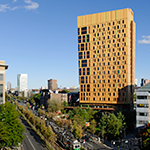When Keith Wolkoff became president of St. Louis-based construction firm PARIC Corporation in 2012, he immediately began pursuing new avenues of growth for the company, both in-state and beyond. This expansion, though, has meant new rounds of hiring, new methods for maintaining efficient communication within the workforce, and new training initiatives to give personnel the confidence and the know-how to advance. Here, Wolkoff explains in his own words how the firm is handling all three.

two years ago and has been growing the company ever since. (Photo: Tom Paule)
My background is as an architect. Very early on, I knew that field wasn’t right for me, so I went to work for a larger construction firm before I came to PARIC in 1998. At PARIC, I covered all areas of the business—from project management to business development—before becoming president in 2012 then buying a portion of the business in 2014. All of this has benefitted me: my architecture background served me well in that I can talk both from the construction perspective and the designer’s perspective; my construction background gave me exposure to a large company’s processes; and now I can see the business from the owner’s perspective.
PARIC now has a 35-year legacy. It’s a well-recognized brand in St. Louis and has consistently been at a certain volume for close to a decade. We’ve worked on some notable projects, including Ballpark Village, a mixed-use entertainment venue—150,000 square feet on a 10-acre site—next to the St. Louis Cardinals baseball stadium.
We’ve overcome challenges over the past few years. We were fortunate in that we saw modest growth during the down cycle, and we positioned ourselves well for the economy to pick up, which we’re now seeing the benefits of. Also, in the past two years, we had leadership changes, we moved our headquarters, and we rebranded. We think we’ve come out of these times better positioned for the future. Our new tagline is “Experience. Excellence.” and that’s been a statement in all of our customer interactions.
We’ve recently made a dedicatedeffort to expand. Within our core markets—academic, health care, tenant improvement, multifamily, historic—we expanded from St. Louis into other areas of the state. In our growth market—senior living, which is being largely driven by an aging demographic—we’ve expanded regionally and are now doing work in Arkansas, Illinois, Kansas, Ohio, and Oklahoma. Right now, we’re one of largest employers of carpenters in St. Louis, so as things are picking up and manpower shortages are becoming a concern, we control a big portion of the labor market.
To grow in the construction field,you have to keep on top of technology. Small changes in technology make a difference. Virtually building projects allows us to identify conflicts up front, not in the field, which [leads to] improved scheduling. For interior finishes, we do robotic layouts instead of having a two-man crew, and it takes about a third of the time. Our superintendents carry iPads in the field, with documents all cloud-based, so if there’s a question, they can address it right there. Also, our current software updates everything automatically, so there’s never a question of whether a document is the most recent.

One project that relied heavily on technology was a student-housing project for Washington University. It’s a $55 million LEED Platinum multiuse complex, located off-campus in the Delmar district of St. Louis. As tight as the floors are vertically, it never would have been as successful as it’s been without our 3-D modeling capabilities.
People are everything. We have a robust corporate talent-management program for the office and are expanding that into the field this year. And, we’re improving our training by developing orientation and 90-day on-boarding programs, and we’re encouraging employees to develop themselves by requiring them to take a certain number of credit hours for continuing education. We’re focused on empowering people, which is a cultural shift in our industry. It’s a high-risk industry, and you have to manage that risk, but if you believe you hired the best people and you train them appropriately, you have to empower them to go out there and make their own decisions. You also have to accept that they’ll make mistakes and [you have to] support them appropriately, Generally, people are way more capable than what we give them credit for.
We’re constantly looking at what’s next. Where do we diversify our market? Industrial? Wastewater? Energy? It could be any one of those three or something entirely different. To decide, we have to look at the emerging trends. We also ask if we have expertise that feeds into another market. For example, for a long time we were perceived as industry leaders in multifamily [construction], and that led us into senior living. So, where’s that next connection? Also, we have to look [to see] if there’s talent within the organization, people with backgrounds we can leverage to grow a new market.


